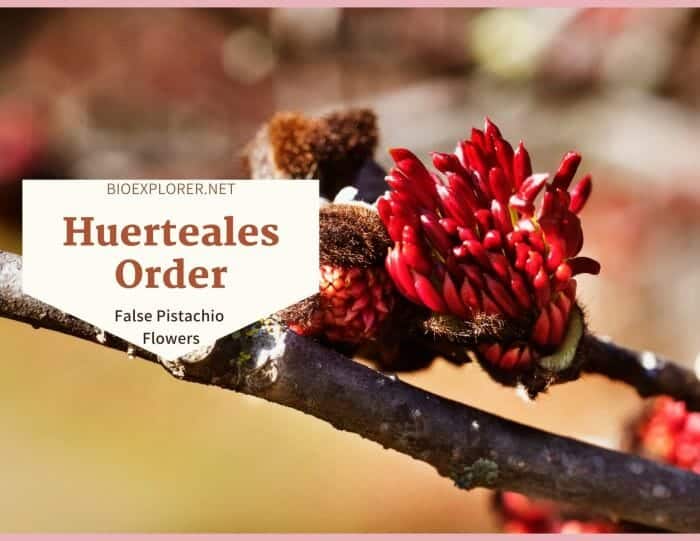
Huerteales is an unusual order of flowers belonging to the rosids, a large eudicot group. The small trees and shrubs are primarily found in tropical or warm temperate regions. Plants in Huerteales usually possess alternate leaves, small and actinomorphicWhat is actinomorphic?A characteristic of the flower exhibiting radial symmetry such as starfish or Daisy flower; capable of being bisected into identical halves along more than one axis, forming mirror images. Opposite is Zygomorphic. flowers, and 5-merous floral parts.
Most Huerteales flowers are bisexual, and all possess nectaries to promote pollination. All species of Huerteales are woody, like the Olomea and False pistachio.
Table of Contents
Huerteales Families
Huerteales was not previously recognized. It is presently placed under Malvidae (formerly known as eurosids II). The wood anatomy of the plants seemed the character that united them. Order Huerteales has accumulated four small families.
- Petenaeaceae (Peten-linden family)
- Gerrardinaceae (Brown-ironwood family)
- Tapisciaceae (False pistachio family).
- Dipentodontaceae (Olomea family)
![]()
Huerteales Distribution
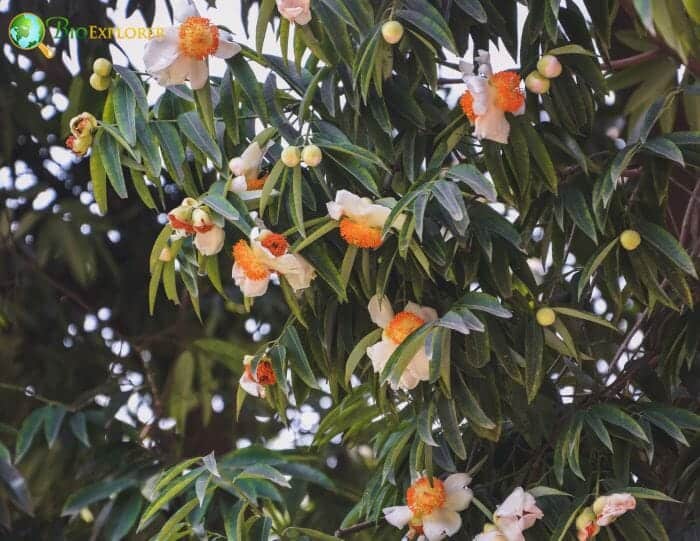
The small trees and shrubs of Huerteales are primarily found in tropical or warm temperate regions.
- The only species of Petenaeaceae, Petenaea cordata, is found in Central America.
- Members of Gerrardinaceae are distributed in eastern to southern Africa.
- The Tapisciaceae species are found in East Asia, Central America, and northern South America.
- The trees or shrubs of Dipentodontaceae are distributed in the eastern Himalayas to East Asia and Pacific Islands.
![]()
Huerteales Characterisitcs
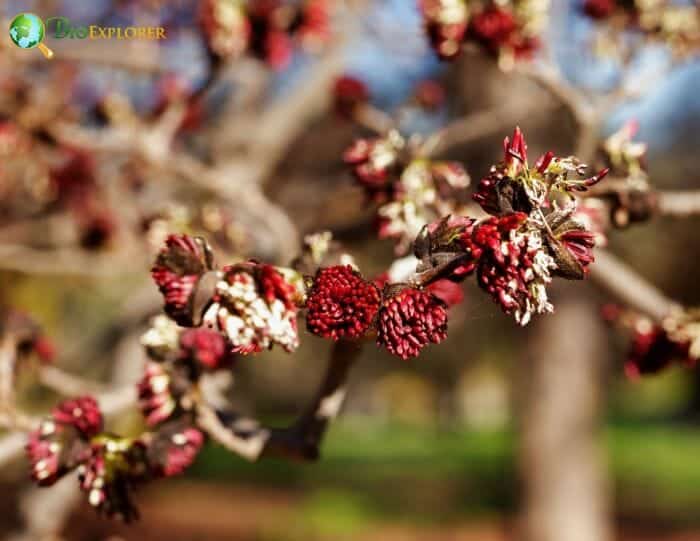
Plants under Huerteales usually share a combination of these characteristics:
- Plant type: Members are mostly trees and shrubs.
- Stem: There is a development of secondary thickening from a conventional cambial ring. The plants have oblique vessel end-walls; scalariform. The nodes are tri-lacunar (Tapisciaceae).
- Leaves: The leaves are alternate, and the lamina margins are toothed. Mostly the stipules are present. However, some species have modified or absent stipules.
- Flowers and inflorescences: The flowers are bisexual and small in cymose panicle, thyrsoid, umbel, raceme-like, spike-like inflorescence; terminal or axillary. The flowers are in a short hypanthium.
- Sepals and Petals: There are commonly 5 sepals and 5 petals. Some species have no petals.
- Stamens and carpels: The number is variable. The flowers have 5-12 stamens and 2-5 carpels.
- Ovary and Fruits: The ovary is unilocular. The fruit is a fleshy berry, capsule, or drupe.
- Seeds: The seeds are minute to small.
![]()
Huerteales Flowers and Reproduction
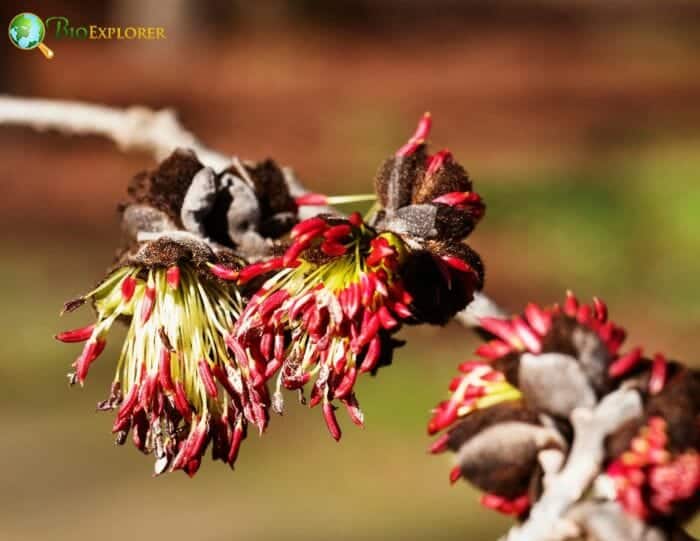
Generally, Huerteales flowers have nectaries and appear to look somewhat similar.
- Gerrardinaceae (1 genus and 2 species[1]) have bisexual and actinomorphic flowers of less than 4 mm.[2] in diameter. They are few-flowered in axillary cymes inflorescence. There are 5-lobed disks that are attached to the hypanthium. The 5 sepals and petals are both free. The stamens are found opposite the petals.
- Petenaeaceae flowers[3] (1 genus and 1 species) are bisexual and actinomorphic in pink hairy panicles. Cymose is the ultimate inflorescence unit. Flowers are many and long pedunculate. The perianth is sepaline with 4 or 5 sepals, and the petals are absent. The stamens are 8-12, and the carpels are 4 or 5. The free hypanthium is absent.
- Tapisciaceae (2 genera and 5 species) flowers are also small in white or yellow. They are male or hermaphrodite and actinomorphic. The flowers are aggregated in inflorescences of racemes or panicles, terminal or axillary. The flowers lack free hypanthium. The calyxWhat is calyx?A collective term for all the sepals of a flower; the lowermost whorl of floral orgrans (Plural form is calyces). and corollaWhat is corolla?A collective term referring to the petals of a flower. are distinct in the perianth. There are 5 sepals and 5 petals. Both are regular and imbricateWhat is imbricate?overlap or cause to overlap; in botany terms, scales, sepals, or plates having adjacent edges overlapping; with margins of structures overlapping like shingles on a roof. in 1 whorl. The 5 stamens are free of the perianth and free of one another, and alternating with the petals. Flowers have (2-)3(-4) carpels.
- Dipentodontaceae flowers[4] (2 genera and 21 species) are bisexual or dioeciousWhat is dioecious?Pertaining to plants, individuals of which bear either staminate or pistillate flowers, but not both. and actinomorphic in 1 to 4 mm. in diameter. The flowers are (4 0r) 5 (-7) to numerous in thyrses in a raceme, panicle, or umbels. The calyx (5-7) and corolla (5-7) are distinct in the perianth. Both the calyx and corolla are in 1 whorl. The petals are slightly narrower or indistinguishable from the sepals. The flowers have 5-7 persistent stamens; oppositisepalous. The carpels are 3.
![]()
Huerteales Family differences
Petenaeaceae
- Members are shrubs to small trees.
- The leaves are simple and alternate. Lamina margins are minutely toothed.
- The venation is palmate.
- The stipules are small.
- The flowers are small, bisexual, and actinomorphic.
- The inflorescences of the flower are in pink hairy panicles. The flowers possess long peduncles.
- There are 4-5 sepals and 0 petals.
- There are 8 to 12 free and glabrous stamens.
- Flowers have 4-5 carpels.
- The fruit is a fleshy, indehiscent berry and the seeds are minute to small and endospermic.
![]()
Dipentodontaceae
- Members are shrubs or small trees.
- The leaves are simple, alternate, and deciduous. The lamina margins are denticulate.
- The leaves are pinnately veined and stipulate.
- The flowers are small, bisexual, and actinomorphic.
- Inflorescences are in pedunculate umbel or thyrses in a raceme or panicle.
- Flowers have 5-7 sepals and petals.
- The stamens of the flower are 5-7, oppositisepalous.
- The flowers have 3 carpels.
- The fruit is a capsule with 1 seed or a berry consisting of 2-4 seeds.
![]()
Gerrardinaceae
- Members are usually shrubs to small trees. Species are sometimes scrambling.
- The leaves are simple and alternate. The lamina margins are toothed and rarely entire.
- The leaves are pinnately veined and stipulate.
- The flowers are small, bisexual, and actinomorphic.
- The inflorescences of the flowers are axillary cymes.
- There are 5 sepals and 5 petals, each in 1 whorl.
- There are 5 stamens opposite the members of the corolla.
- Flowers have 2 carpels.
- The fruit is a fleshy or dry berry.
![]()
Tapisciaceae
- Members are small trees and shrubs.
- The leaves are petiolate, compound, and alternate. Members are odd-pinnate, possessing 5-9 leaflets.
- The lamina margins are serrate. If the stipules exist, they are caducous.
- The flowers are small, male or bisexual, and actinomorphic.
- The flowers are aggregated in racemes or panicles.
- The sepals are 5-lobed; tubular. The petals are also 5.
- There are 5 stamens, mostly exserted.
- The flowers are (2-)3(-4) carpelled.
- The fruit is a berry or a drupe, indehiscent.
![]()
Huerteales Example Species
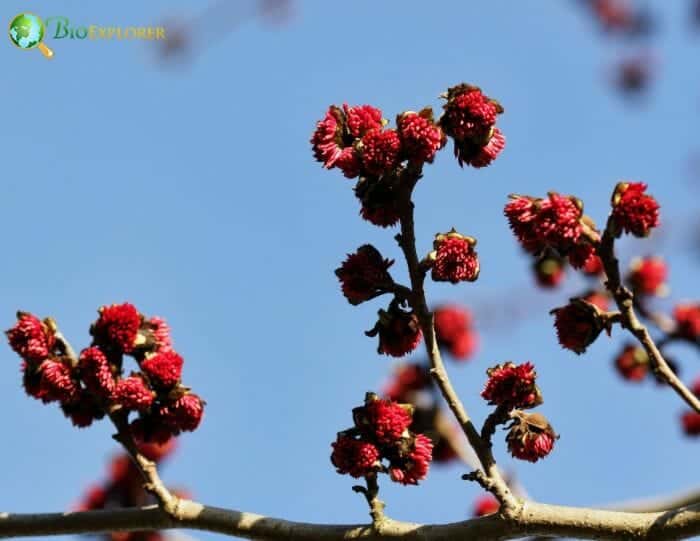
All of the members of Huerteales are woody plants. The following are the plants under this order.
- Olomea – This plant is used for landscaping.
- Krantz berry – It is a medicinal plant[5].
- False pistachio – This plant has excellent value for medicine[6], furniture production and is used as ornamental trees.
- Dipentodon sinicus – This plant has derivatives with great potential for medicinal use[7].
- Perrottetia arisanensis- This plant possesses compounds for possible medicinal use[8].
- Perrottetia mutiflora – The plant possesses compounds for possible medicinal use[9].
- Brown-ironwood
- Male cedar of Peru or Cedrillo.
- Tapiscia yunnanensis
- Petenaea cordata
![]()











